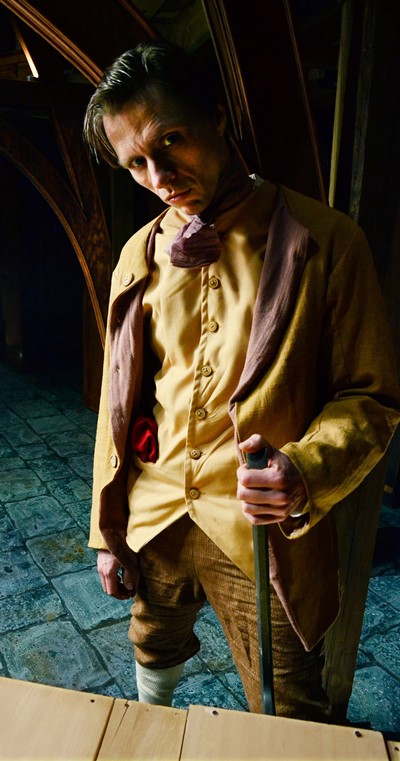In a compressed ‘Tale of Two Cities,’ Lifeline touches the heart of sacrifice in time of chaos
 Review: “A Tale of Two Cities,” adapted by Christopher M. Walsh from the novel by Charles Dickens, at Lifeline Theatre through April 13. ★★★
Review: “A Tale of Two Cities,” adapted by Christopher M. Walsh from the novel by Charles Dickens, at Lifeline Theatre through April 13. ★★★
By Lawrence B. Johnson
It’s a good trick, reducing an epic – and I might add really famous – novel like Dickens’ “A Tale of Two Cities” to two hours’ worth of narrative and dialogue, and yet preserving the psychological and dramatic dimensions that make the story compelling. Credit Lifeline Theatre with doing just that.
Specifically, props go to adaptor Christopher M. Walsh for what might best be described as an intensive abridgement of Dickens’ book, to director Elise Kauzlaric for making optimal use of Lifeline’s small space without turning the story into a fire-drill of entrances and exits, and to a group of actors who imbue iconic characters with genuine motivation, gain and loss.
 That much said, it’s also true that Lifeline’s “Tale of Two Cities” is more remarkable as an exercise, a translation with constraints from one medium to another, than as a play conceived as such from scratch. There’s just so much to pack in – a ledger of accounts many viewers will know almost by heart – that the end result cannot escape the aura of a skillfully executed check list.
That much said, it’s also true that Lifeline’s “Tale of Two Cities” is more remarkable as an exercise, a translation with constraints from one medium to another, than as a play conceived as such from scratch. There’s just so much to pack in – a ledger of accounts many viewers will know almost by heart – that the end result cannot escape the aura of a skillfully executed check list.
Framed by the onset of the French Revolution, in 1789, “A Tale of Two Cities” is the love story of three people caught up in the rising and bloody tide of human events. Two men, the dissolute English attorney Sydney Carton and the disavowed French nobleman Charles Darnay, both adore the beautiful Lucie Manette. She’s Darnay’s for the asking – but in the end, only Carton’s for the giving.
What we must believe in, first of all, is the heart and soul of the debauched Carton, whose alcoholic self-debasement has removed any possibility of a life with fair Lucie. Josh Hambrock’s bleary, self-loathing Carton rivets attention not just when he speaks but even when he’s merely in view. Here is a man of agile mind and great potential who simply cannot keep it together.
 This wreck of a creature may be the most capable of characters, and he is certainly the most interesting. When Hambrock’s Carton, desperate to certify his earthly value, commits his last full measure of devotion to Lucie’s happiness, the impression is not one of Dickensian ritual but of an earnest gesture. For my own part, I wasn’t visualizing a page in the book – silently reciting along, so to speak; I was looking into Hambrock’s eyes.
This wreck of a creature may be the most capable of characters, and he is certainly the most interesting. When Hambrock’s Carton, desperate to certify his earthly value, commits his last full measure of devotion to Lucie’s happiness, the impression is not one of Dickensian ritual but of an earnest gesture. For my own part, I wasn’t visualizing a page in the book – silently reciting along, so to speak; I was looking into Hambrock’s eyes.
Maggie Scrantom offers a charmingly innocent Lucie, with Sean Sinitski as her ill-used father, Doctor Manette, now liberated from the Bastille after long and unjust imprisonment there at the hands of the Evremondes.
What also works effectively is the conflict between Lucie’s betrothed Darnay (the elegant Nicholas Bailey) and his licentious, self-indulgently aristocratic uncle, the Marquis St. Evrémonde, played with delicious, indeed daunting, haughtiness by Chris Hainsworth. We see enough of Hainsworth’s lustful, unrestrained Evrémonde to understand why a younger man with any conscience at all might rebel against his noble upbringing.
 Score a double coup for Hainsworth as Dickens’ bad guys we love to hate. He also does worthy service as the spy-for-hire John Basard, whose name lacks only a T to be self-descriptive.
Score a double coup for Hainsworth as Dickens’ bad guys we love to hate. He also does worthy service as the spy-for-hire John Basard, whose name lacks only a T to be self-descriptive.
Central to the story, of course, is the formidable Madame Defarge, taciturn wife of a Paris wine-shopkeeper — she of the knitting needle and ever-lengthening list of those who shall know Lady Guillotine when the people rise up. Carolyn Klein’s single-minded Madame, tight-lipped and all-seeing, is one scary conspirator. Just as Dan Granata’s Monsieur Defarge, resolute but excitable and never quite willing to challenge his wife, is not.
To move this shrunken version of Dickens along, adaptor Walsh has promoted a minor character from the novel, a thief of buried bodies or “resurrection man,” to omniscient narrator. John Henry Roberts’ gaunt, sardonic portrayal affords a constant reminder of the darkness of the story now unfolding. This almost spectral figure is the connecting thread, and his narrative electrifies the drama.
The two-level set devised by Joe Schermoly helps to minimize the congestion of characters coming and going, intersecting with — and evading — each other. It is a tale adroitly told: clear, taut and affecting.
Related Link:
- Performance location, dates and times: Details at TheatreinChicago.com
Tags: Carolyn Klein, Charles Dickens, Chris Hainsworth, Christopher M. Walsh, Dan Granata, Elise Kauzlaric, Joe Schermoly, John Henry Roberts, Josh Hambrock, Lifeline Theatre, Maggie Scrantom, Nicholas Bailey, Sean Sinitski, Tale of Two Cities

